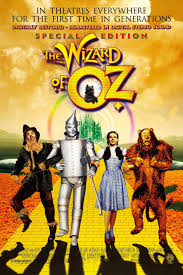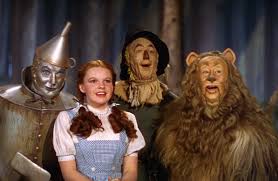REVIEW:
The Wizard of Oz is an absolute classic. It might be the first real fantasy movie of all time. And that’s an odd statement, because there were certainly out-there, sci-fi black and white, movies like the Cabinet of Doctor Calgary and Nosferatu before this. But the Wizard of Oz was the first movie to combine fantasy with color, and to let us really see how beautiful an imaginary world could be. Let’s put it this way… without the Wizard of Oz, you’re not getting the Lord of the Rings movies or Harry Potter or anything else in the genre.
The movie is about Dorothy, a young girl who lives on a farm in Kansas and gets transported to another world when her house gets sucked up by a tornado. It’s a little like Alice in Wonderland, in the sense that she has to go through a sort of tunnel or hole to get to this other world with all kinds of mystical creatures. I suppose both the tornado (funnel, tunnel,) and the hole that Alice falls down represent portals or gateways to another world.
The Wizard of Oz starts in black and white, and then transitions to color when Dorothy arrives in Oz. That change over, which occurs when Dorothy opens the door of her house and looks out at this new world for the first time, is handled perfectly. You really feel the colors and the change, and how beautiful this fantasy world appears. And the vibrant colors wouldn’t have nearly as much of an impact, if the beginning hadn’t been all in black and white. Depriving us of color at first has a huge payoff when Dorothy arrives in Oz.
Dorothy steps outside and meets Glinda, who arrives by floating down from the sky in a pink bubble. Glinda tells Dorothy about how Dorothy’s house landed on an evil witch. And we see this Witch’s legs and ruby slippers, crushed under the house. Then we meet the dead witch’s sister, the Wicked Witch of the West. Her skin is green, and she arrives in burst of fire, carrying a broomstick with her, whenever she goes. She has a cackling laugh and is clearly presenting herself as evil, every step of the way.
Naturally the Wicked Witch of the West is angry that Dorothy killed her sister, even if it was an accident. But what makes it worse is that Dorothy refuses to give up the dead witches Ruby slippers, which Glinda insists are Dorothy’s now. From the Wicked Witch of the West’s point of view, the anger she has all makes sense. Why is this girl stealing her dead sisters shoes and refusing to give them up? For Glinda it’s a matter of that the shoes appeared on Dorothy’s feet, so it must mean something, like they were meant to be hers. It’s all pretty weird.
Dorothy next meets the munchkins who are incredibly strange and do some wonderful singing and dancing. This movie wasn’t afraid to use little people in the role of munchkins, just like Willy Wonka and the Chocolate Factory did for Oompa Loompas. Of course, we are long past those days now, and in all remakes of these stories, the characters are played by regular sized actors as to not offend anyone (the Timothy Chalamet Wonks movie has Hugh Grant as an Oompa Loompa and Wicked features a regular sized man claiming he’s a munchkin.) But there’s something nice about the simpler time this movie existed in.
Soon Dorothy is off on her journey, traveling down the yellow brick road. She meets the Scarecrow, Tin Man, and Cowardly Lion all one at a time. And each one sings a pretty great song to her as part of his introduction. The ideas here, which date back to the book, about how each of these three characters is missing something, are pretty cool. A brain, a heart, courage. And each of them wants to go to the Wizard with Dorothy to see if he will give them these things.
And so they head off on their journey, which now involves a number of run ins with the witch as she tries to stop them from reaching the Wizard. First she meets them in the middle of the woods and throws fire at the scarecrow. Then she causes a the field between them and Oz to get filled with poppy flowers that put them to sleep. None of it works. And when Dorothy and company finally does reach her destination and meet the Wizard, he sends her back to the Witch to get her broomstick.
It’s a bit of an unusual order, having the character reach the end goal only to be sent back to the antagonist. But it works because it gives Dorothy the final showdown and the climax we needed. And I like that the final act isn’t rushed. Instead, we see Dorothy get kidnapped and her three friends have to dress up like guards to come to her rescue. It all works great. So does Dorothy’s return to Kansas where she realizes the different people she knows there factored into her “dream,” about Oz. That includes each of the three stage hands as well as the fortune teller, who took on the role of the Wizard.
If Alice and Wonderland is more of a drug trip, than the Wizard of Oz is more of a dream. And both are fantastic movies filled with wildly imaginative ideas. It’s funny to think that our first versions of fantasy on film all involved little girls as opposed to knights and action. It was a simpler time when it was about the discovery of creatures and rules, more than the thrills. And as both a fantasy and a musical, the Wizard of Oz is quite a success.

